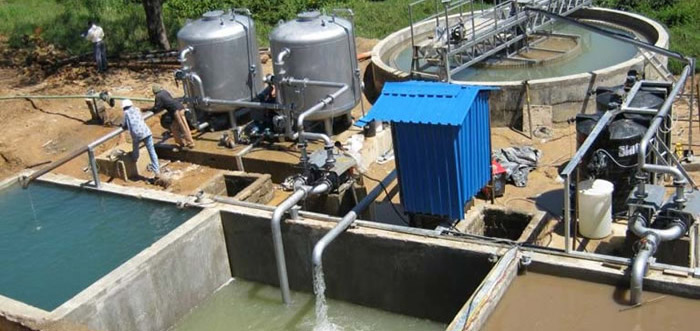Modification Of ETP Plant

Modification Of ETP Plant – An Effluent Treatment Plant is a facility designed to treat industrial wastewater, also known as effluent, before it is discharged into the environment. The primary goal of an ETP is to remove pollutants, contaminants, and harmful substances from the wastewater, making it safe for release into rivers, lakes, or other receiving bodies or for reuse within the industrial process.
The key components of an Effluent Treatment Plant typically include:
Screening:
The wastewater is initially screened to remove large particles and debris.
Primary Treatment:
In the primary treatment phase, physical processes such as sedimentation and flotation are used to separate suspended solids and other larger particles.
Secondary Treatment:
Biological processes, such as activated sludge treatment or biological filters, are employed in the secondary treatment stage to further break down organic matter and remove nutrients.
Tertiary Treatment:
Tertiary treatment involves additional processes to polish the effluent further and meet specific discharge standards. This may include processes like filtration, chemical treatment, or advanced oxidation.
Disinfection:
Disinfection is often performed to kill or deactivate harmful microorganisms remaining in the effluent before discharge.
Sludge Handling:
Sludge, which is the solid material separated during the treatment process, is often treated separately. This may involve processes like thickening, dewatering, and sometimes anaerobic digestion or incineration.
Modifications of ETP Plant can be made for various reasons, including changes in regulatory requirements, increased wastewater loads, advances in treatment technologies, or the need for higher treatment efficiency.
Some common modifications of ETP Plant may include:
Capacity Expansion:
If the industrial facility expands its operations or production capacity, modifications to the ETP may be necessary to accommodate the increased volume of wastewater.
Upgrading Treatment Processes:
Upgrading the treatment processes to more advanced or efficient technologies can improve the overall performance of the ETP.
Compliance with New Regulations:
Changes in environmental regulations may require modifications to ensure that the ETP meets the updated standards and discharge limits.
Integration of Advanced Technologies:
Incorporating new technologies, such as membrane bioreactors, reverse osmosis, or other advanced treatment methods, can enhance the ETP’s capabilities.
Automation and Control System Upgrades:
Upgrading the automation and control systems can improve the operational efficiency and monitoring capabilities of the ETP.
Resource Recovery:
Modifications may be made to the ETP to implement resource recovery processes, such as nutrient removal or the extraction of valuable by-products from the wastewater.
Energy Efficiency Improvements:
Implementing energy-efficient technologies or renewable energy sources can reduce the environmental impact and operational costs of the ETP.
Adaptation to Changes in Wastewater Characteristics:
If the nature of the industrial process changes, leading to alterations in the composition of wastewater, the ETP may need modifications to effectively treat the new contaminants.
Advantages of Upgrading ETP Plants
- Improved Treatment Efficiency: One of the primary advantages of upgrading an ETP plant is enhanced treatment efficiency. With advanced technologies and equipment, upgraded plants can effectively remove a wider range of pollutants from wastewater, ensuring cleaner effluent discharge.
- Compliance with Environmental Regulations: Upgraded ETP plants are designed to meet or even exceed stringent environmental regulations set by regulatory bodies. By investing in upgrades, industries can ensure their operations remain compliant while minimizing the risk of penalties or legal issues.
- Reduced Water Consumption: In many cases, upgrading an ETP plant involves implementing water-saving techniques such as recycling and reusing treated water within the industrial process itself. This not only reduces freshwater consumption but also lowers operational costs associated with purchasing and treating additional water.
- Energy Savings: Modernizing an ETP system often incorporates energy-efficient technologies that reduce power consumption during wastewater treatment processes. By using energy wisely, industries can decrease their carbon footprint while cutting down on utility expenses.
- Enhanced Reputation: Upgrading an ETP plant demonstrates a company’s commitment to sustainability and responsible environmental practices. Such initiatives contribute to building a positive reputation among customers, employees, investors, and communities at large.
- Innovative Solutions for New Challenges: As technology advances, so do the challenges faced by industries regarding wastewater treatment. Upgrading allows businesses to adopt innovative solutions tailored to address new types of pollutants or emerging contaminants present in their effluents.
Conclusion:
As industries continue to grow and expand, the need for efficient and effective effluent treatment plant becomes increasingly crucial. With stricter regulations being imposed on wastewater discharge, it is essential for businesses to invest in upgrading their existing ETP systems.
The modifications discussed in this article provide insights into how ETP plants can be improved to meet current environmental standards. By implementing these changes, companies can not only ensure compliance but also reap numerous advantages such as reduced operational costs, increased efficiency, and enhanced sustainability.
However, it is important to acknowledge that modifying an ETP plant comes with its own set of challenges and limitations. Factors like space constraints, technical expertise requirements, and financial considerations may pose obstacles during the upgrade process. Nonetheless, with careful planning and consultation with experts in the field, these hurdles can be overcome successfully.